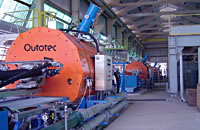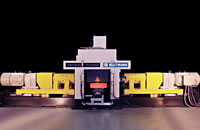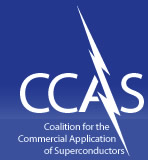Commercial Applications
- Properties, History and Challenges
- Overview
- Electric Power
- Transportation
- Medical Imaging and Diagnostics
- NMR for Medical and Materials Applications
- Industrial Processing
- High Energy Physics
- Wireless Communications
- Instrumentation, Sensors, Standards and Radar
- Large-Scale Computing
- Renewable Energy
- Cryogenics: An Enabling Technology
Applications in Industrial Processing
Low Temperature Superconductor (LTS) magnets enable the large magnetic separators used in the kaolin clay industry. Copper magnet technology was displaced beginning in 1986 as already installed systems were retrofitted and new systems were based on superconducting technology. The fundamental properties of superconducting materials impart performance properties to the magnet that cannot otherwise be achieved.
Kaolin Clay Processing
Kaolin is a white filler used extensively in paper and ceramic products. Annual production value is more than $3 billion. The United States is the largest manufacturer and exporter, with most of the production located in Georgia. Kaolin clay, as mined, contains low levels of ferromagnetic and paramagnetic impurities which act as color centers and must be removed to achieve the required “brightness.” This was accomplished using environmentally unfriendly bleaching agents until 1973, at which time high gradient magnetic separators (HGMS) were introduced, based on wide bore (84-120 inches diameter) copper magnets. In this process, a kaolin clay slurry is passed through a tube packed with stainless steel wool that becomes magnetized when the field is turned on. Impurities adhere to the steel wool and are removed by back flushing with the field off. Throughput is directly related to field strength, and continuous operation at maximum throughput is the economically desired mode.
Advantages of Superconductor Based Separators
 [1]The overwhelming benefit realized by replacing copper by superconductor in magnets for kaolin clay processing is derived from the fundamental properties of the superconducting material. Copper separators typically operate at a field strength of 1.8 T (1.8 Tesla) with a practical upper limit of about 2.0 T. Conversely, a superconductor based unit is typically designed to operate at 5 T. As kaolin throughput
is linearly related to field strength, superconductor units have a clear advantage in productivity.
[1]The overwhelming benefit realized by replacing copper by superconductor in magnets for kaolin clay processing is derived from the fundamental properties of the superconducting material. Copper separators typically operate at a field strength of 1.8 T (1.8 Tesla) with a practical upper limit of about 2.0 T. Conversely, a superconductor based unit is typically designed to operate at 5 T. As kaolin throughput
is linearly related to field strength, superconductor units have a clear advantage in productivity.
Furthermore, large, copper-based magnetic separators require about 400kW per hour. When the copper coils are replaced with superconductor, the energy needed for the same kaolin throughput drops to 200W, and overall energy consumption is reduced by >95%. The continuing rise in energy costs further favors superconductor systems and more than offsets the modest capital investment premium.
Emerging HTS Systems
Several industrial applications have been identified as ideally suited for high field HTS based magnets and are being pursued. These applications include pre-treatment of water to prevent scale formation in boilers and heat exchangers, treatment of wastewater streams, remediation of solid wastes and clean up of radioactive waste. Other opportunities are in materials manufacturing such as semiconductor production in high magnetic field and induction heating.
HTS Induction Heater
 A new generation of non-ferrous induction heaters with
shorter heating times and nearly double the efficiency of conventional induction
heaters is now commercially available. A key element of these unique machines is the
rotation of the work piece. HTS induction heaters, available in sizes between 0.25 MW
and 2 MW of thermal rating, revolutionize aluminum, copper and brass billet heating
prior to extrusion, cutting energy demand and operating costs to almost half, since
there are virtually no electric losses. The induction coils are manufactured from
advanced HTS material, chilled with compact machine-mounted chillers to 30 K and
carry high direct current, with virtually no losses. To create the induction heating effect,
the billet is rotated in a powerful electromagnetic field - the speed profile being
determined by the size of billet and type of material. As well as doubling operating
efficiency, the HTS induction heater requires less maintenance and is expected to have
a longer working life, because of no conventional thermal loads. For the same reason,
tool changing is faster and safer. The bottom line is improvement in productivity,
flexibility and operating costs. [2]
A new generation of non-ferrous induction heaters with
shorter heating times and nearly double the efficiency of conventional induction
heaters is now commercially available. A key element of these unique machines is the
rotation of the work piece. HTS induction heaters, available in sizes between 0.25 MW
and 2 MW of thermal rating, revolutionize aluminum, copper and brass billet heating
prior to extrusion, cutting energy demand and operating costs to almost half, since
there are virtually no electric losses. The induction coils are manufactured from
advanced HTS material, chilled with compact machine-mounted chillers to 30 K and
carry high direct current, with virtually no losses. To create the induction heating effect,
the billet is rotated in a powerful electromagnetic field - the speed profile being
determined by the size of billet and type of material. As well as doubling operating
efficiency, the HTS induction heater requires less maintenance and is expected to have
a longer working life, because of no conventional thermal loads. For the same reason,
tool changing is faster and safer. The bottom line is improvement in productivity,
flexibility and operating costs. [2]
- [1] Industrial LTS Magnetic Separator. Image courtesy of Outotec (USA) Inc.
- [2] HTS Induction Heater. Image courtesy of Zenergy Power.

